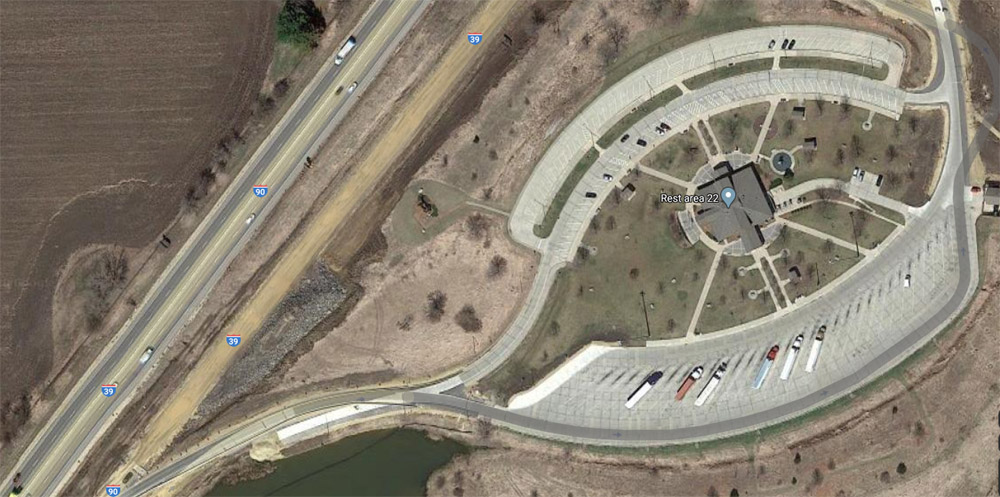
Beloit Welcome Center
- Rest Stop 22
- 71 car and 30 truck parking stalls
- Men's and women's restrooms
- Family/assisted restroom
- Handicapped accessible
- Diaper changing facilities
- Drinking water
- Vending machines
- Travel and weather info
- Picnic area and tables
- Children's play area
- Prairie demonstration plot
- Pet exercise area
- Recycling areas
Features
- Original rest area opened in 1967.
- Old "Spired-hip" style building was located by current exit ramp.
- Specially designed building and enlarged site opened in 1997.
- Cut stone veneer and timber building exterior.
- 'Welcome to Wisconsin' signs for photo opportunities.
- Medal of Honor Wall, listing Wisconsin recipients, located on site.
- "The Medal Of Honor" Historical Marker located on site.
- "Black Hawk War" Historical Marker located on site.
- Beloit Travel Wisconsin Welcome Center located on site.
Parking
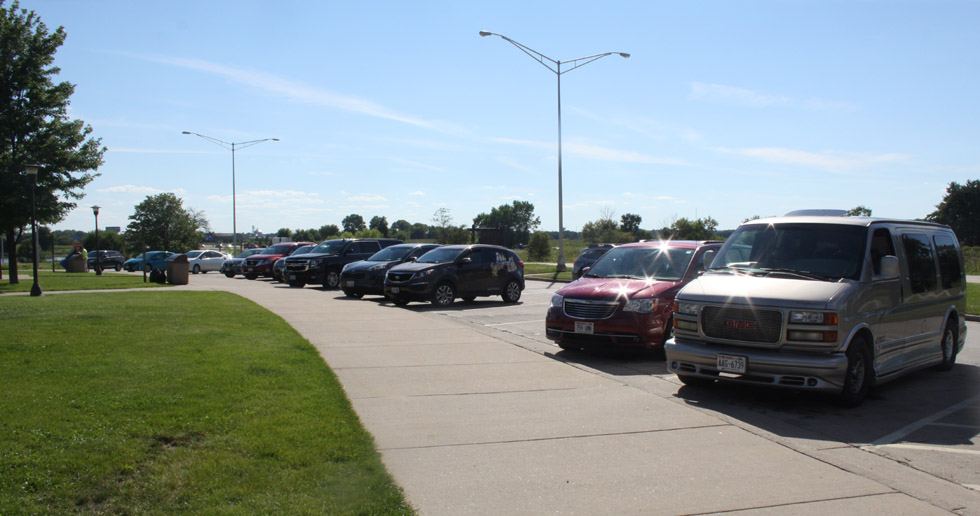
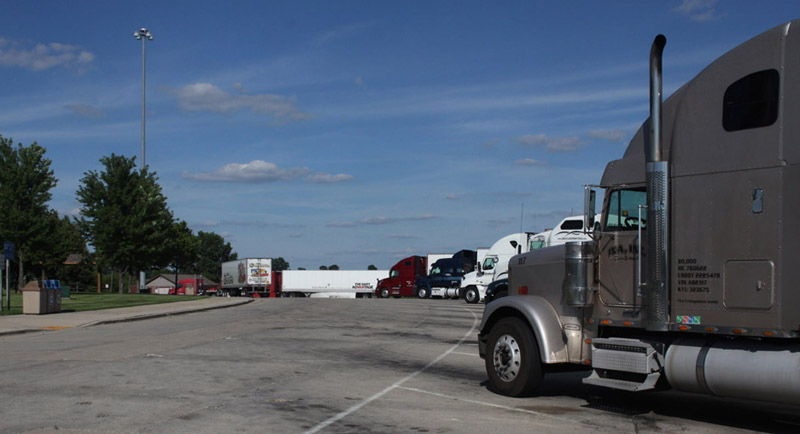 This rest area has parking spaces for 71 cars and 30
trucks. Parking is offered in three areas. There is a
truck and large vehicle paring area in the back,
secluded from the highway and from the bustle of regular
travelers. It has the large pull though style of parking
spaces that dispense with the requirement to back out or
navigate. For standard automobiles, there is a parking
area directly in front of the grounds bordering the
pavilion, and anther area for overflow separated by a
grassy median strip.
This rest area has parking spaces for 71 cars and 30
trucks. Parking is offered in three areas. There is a
truck and large vehicle paring area in the back,
secluded from the highway and from the bustle of regular
travelers. It has the large pull though style of parking
spaces that dispense with the requirement to back out or
navigate. For standard automobiles, there is a parking
area directly in front of the grounds bordering the
pavilion, and anther area for overflow separated by a
grassy median strip.
Parking is generally not allowed for more than 24 hours, and camping of any kind is prohibited. What the camping prohibition means is that trailers must remain hitched, and any slide outs or pop ups must be kept closed. The stops are regularly patrolled, and are quite safe; but are not meant to take the place of a hotel room or camp grounds. Their main function is to provide rest room facilities, and to give drivers a chance to pull over and prevent accidents caused by driver fatigue.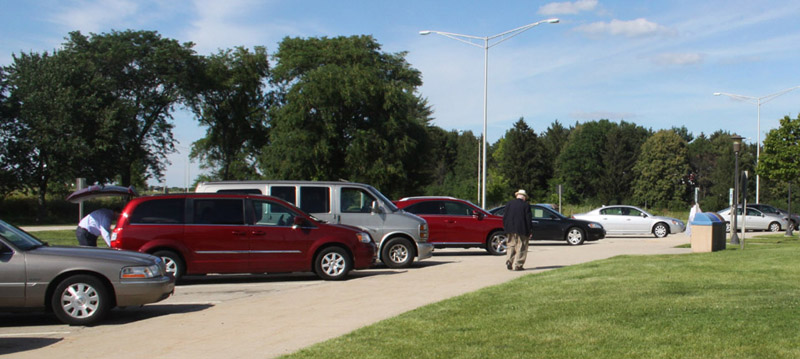
All parking areas are approached by long ramps with acceleration areas to get back up to speed when entering the highway. Traffic is strictly one way, and move sin the same direction as the highway. Trucks and cars are separated, upon entry, with trucks going off to their own secluded area out back, and cars going to the more public area to the left.
The aerial view at the top of the page gives a pretty good idea of the layout of the parking areas, and of the rest area site in general.
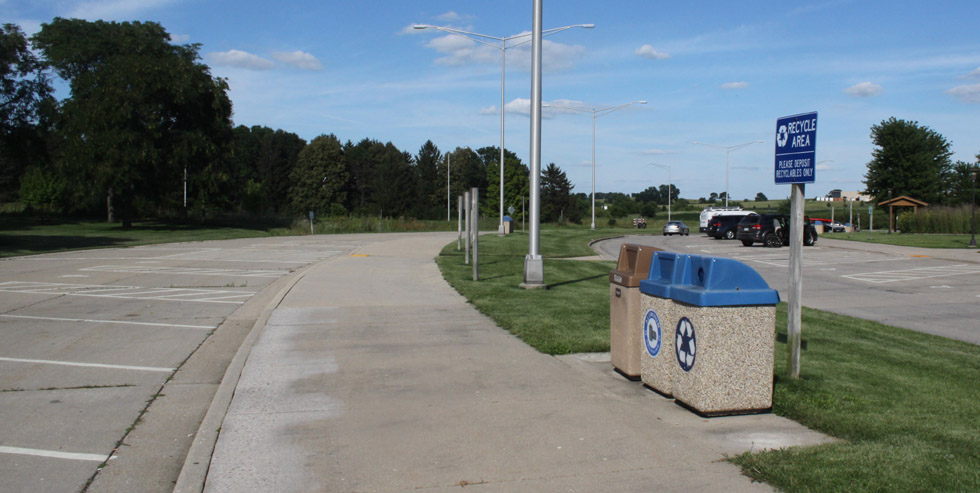
Parking is generally not allowed for more than 24 hours, and camping of any kind is prohibited. What the camping prohibition means is that trailers must remain hitched, and any slide outs or pop ups must be kept closed. The stops are regularly patrolled, and are quite safe; but are not meant to take the place of a hotel room or camp grounds. Their main function is to provide rest room facilities, and to give drivers a chance to pull over and prevent accidents caused by driver fatigue.
All parking areas are approached by long ramps with acceleration areas to get back up to speed when entering the highway. Traffic is strictly one way, and move sin the same direction as the highway. Trucks and cars are separated, upon entry, with trucks going off to their own secluded area out back, and cars going to the more public area to the left.
The aerial view at the top of the page gives a pretty good idea of the layout of the parking areas, and of the rest area site in general.
Commemorative
In most cases, the historical marker will indicate local people or events that are memorable or remarkable in some way. In certain other cases, the markers may represent larger state or national figures or events.
In the case of the Beloit rest area, a marker recalls the events of the Black-hawk war, which took place in south central and southwest Wisconsin, extending to the Mississippi River.
Another marker designates this portion of the Interstate system as the Wisconsin Veterans Memorial Highway.
Prairie
People mostly think of Wisconsin as a land of woodlands, forests, and dairy farms. While there are woods up north, this part of Wisconsin was largely composed of the kinds of grasslands most people associate with the plains states further to the west.
When you look at the woodlands in this part of the state, you discover they were mostly planted and are not part of the native vegetation. The original look of this part of the state has been recreated here in a large pair of plantings bisected by a walkway.
Walking through this area is like strolling down a corridor of grass. Many of the grasses grow taller than a grown man, and support a surprisingly large population of insects and other small critters. In their natural state, covering mile after mile of the countryside, they likely provided welcome cover from predators, large amounts of browse for large and smal
Today, most of the native prairie is gone, paved over for cities, plowed under for farms, or replanted as recreational or commercial lumber woodlands. None of this is necessarily bad, but it is a fact that the ecology of the area has been greatly changed. In addition to the change in flora, the animal life has greatly changed. There are no longer large herds of animals feeding off of the native grasslands, nor are their any bears, wolves, or wild cats remaining of those that once fed upon them. The buffalo were hunted out by the 1830's and the elk were gone by the 1880's. There are some efforts to reintroduce these animals, along with the bears, wolves, and other predators that once fed upon them, with mixed results, mostly in the northern part of the state.
Along these brief trails, are a pair of signboards that indicate something about these species of grass, and the habitats they created. They also give some indication of just how significantly has been the change that occurred here. Walking
One signboard indicates the impression that the new lands made upon the new settlers, and gives some idea of the animals that once abounded here. The other signboard gives an explanation of how the various prairie grasses adapted and formed the base around which the prairie was formed and sustained. Both are worth a moment of time to read and consider.
All of the rest areas do this, with the particular display varying to reflect the native vegetation of the area in which it resides.
Picnic
The grounds are well stocked with picnic tables permanently anchored onto concrete bases. The hard pack helps keep away the bugs, and keeps the picnic areas from being churned into mud on rainy days. Some picnic tables are open to the sky, and others are enclosed in little shelters.
The last time I checked, grilling is allowed with propane or electric, but not with charcoal or any other kind of fire. No campfires allowed.
The distribution of picnic tables gives a choice of being near the parking area, a secluded spot in the woods, or a grassy area. There are also a number of them right near the pavilion.
The benches provide a nice
I have seen a respectable number of coolers and picnic baskets here, so the secret may be out. Unlike city parks in many areas, the rest stop never closes.
These areas and all of the grounds are kept perfectly manicured, except for a few spot that are allowed to grow wild. This helps with tick and mosquito control.
Grounds
There is a very small playground area to burn up some energy, and wear the kids out so they will snooze in the car. It is underlain by a well padded relatively soft ground to help moderate the inevitable falls.
Access to everything is easy through walkways, plazas, porticoes, and pathways. Many of these have benches and ledges where visitors might sit and relax. Or a tired travel might just sprawl out on the grass, or take it easy at a picnic table. Walking paths go around the central pavilion, and off to the parking areas and picnic areas.
Casual automobile travelers have their own areas towards the front of the pavilion, along with their own pair of parking areas. Commercial truck drivers have an area of their own at the back.
The grounds are tended by state crews every week. The grass in most areas is kept short enough that concerns over ticks and other biting insects are small. I have never seen a scrap of litter or mess anywhere on the grounds, or in the pavilion.
There is nothing like taking a short respite in one of these places, smelling the fresh air and hearing the traffic sounds.
Medal of Honor
The Medal of Honor memorial is set into a berm, and displays the names of the men so honored, on black marble tablets. These tablets are then set into a stone wall. The wall is flanked by benches, and framed by a plaza within which fly the flags of Wisconsin and of the United States.
In the entire history of the United States, only 61 soldiers from from Wisconsin received this award, with a third being awarded during the Civil War, and another Quarter during WWII. The award was given out for the type of exceptional valor that does not usually engender survival.
Each of the black tablets honors those that were warded the medal, according to the action fought. Their names and ranks at the time of the award are engraved. For those who are not students of history or of the military, a marker stands just outside of the memorial, explaining the significance and rarity of the award.
Billy Mitchell, at one time disgraced and dishonored, was later awarded a special gold MOH, for his proof and advocacy of the application of air power.
In addition to the tablets, there is a small plaza with flags for Wisconsin, and The United States. There is also a marker explaining the award, and Wisconsin's part in the military. The memorial is just off to the side of the pavilion.
Each of the black granite tablets is inscribed with the names of those who served and were recognized, and the dates of the awards. They are polished to a nearly mirror like finish, except for the rough hewn stone at the top. The middle tablet has a depiction of the medals, which vary somewhat between the services, themselves..
Most if not all of the men commemorated here died in the actions for which they were awarded the medal. In Wisconsin, as of this writing, there are currently three living Medal of Honor recipients. All are somewhat aged, and may not be with us too much longer. One is 90 years old (Einar H. Ingman, Jr.of Irma), One is 72 (Gary Wetzel of Oak Creek) and the last is 75 (Kenneth E. Stumpf of Tomah) In the country as a whole there are only eighty living Medal of Honor recipients.
No such award has been given to a Wisconsin recipient since Vietnam; but there is room on the last tablet for additional wars and additional entries. There always seems to be one more war.
Like most war memorials, this is meant to be a solemn place. The design is a cross between a cemetery and a site marker. The flagpoles add to the formality of the place; we are never completely at ease in the presence of furled flags. There are no benches, ledges or other places to sit here. It is not a place to sit at ease, but a place to stand respectfully, and honor heroes. There are no flowers and no grass to soften the monument. There are some trees planted into the berm into which the memorial is set, and someday they will provide shade, but even then they will not soften the lines of the place. For now, there are too small to have much of an effect.
The tablets are set within the same stone veneer which is used as facing for the pavilion. One of the side porticoes of the pavilion ls directly into the memorial, and the matching stone facing integrates the memorial with the pavilion.
Pavilion
This is an extremely massive building, constructed of steel and concrete. It is finished off in field-stone. It has large porticoes over three of its four entrances, with the fourth entrance being for deliveries and maintenance. The high gabled roof is pitched, and has windows set over the gables to let in the sun.
The current structure was built in 1997, and still looks new. It will likely last for hundreds of years. These buildings are always spotlessly clean, and are usually maintained by local groups such as the council for the blind, or Easter Seals. The vending machines are similarly maintained and kept stocked. The machines help keep the building financed, and though they are not self supported, they place less of a burden on state taxes than would otherwise be the case.
Inside, there is travel and weather information, via video display. There is no WiFi, and there are no payphones.
Inside
While tourist brochures and advertising sheets are not unheard of at rest stops, they no longer dominate the way that they did before the Internet. A visit to a rest stop in the last century, or in the first decade of this century, would have presented the traveler with a deluge of maps, folders, magazines, newsletters, and pamphlets, all extolling the virtues of the various tourist areas, traps, and attractions. Walls, entryways, hallways, and stand alone displays would be filled with rack after rack.
The Internet has largely negated the need for such offerings, but the welcome centers do have tourist centers, which are staffed and have all the paper to warm an old fashioned tourists heart. This one happened to be closed upon my arrival, though the rest of the building was open, due to it being late on a Sunday. I managed to get a shot of it through a window.
As a welcome center, this rest area is somewhat larger than most. The bunker like construction makes it less expensive to heat and cool, and more difficult to vandalize. This last is a factor because these areas are open 24 hours, and frequently un-staffed.
Like any public building, they are built of long wearing non-porous materials that are easy to clean, and nearly indestructible. The ceilings are high, the spaces are large, and everything is well lit.
At the time of my visit, the place was too busy for me to get my usual rest room photographs. Maybe next time.